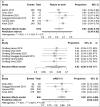Return to Work After Ischemic Stroke in Young Adults: A Multicenter Cohort Study, Systematic Review, and Meta-Analysis
- PMID: 40178096
- PMCID: PMC12132830
- DOI: 10.1161/JAHA.124.036427
Return to Work After Ischemic Stroke in Young Adults: A Multicenter Cohort Study, Systematic Review, and Meta-Analysis
Abstract
Background: Ischemic stroke incidence in young adults is increasing globally, with return to work (RTW) a key rehabilitation goal. We aimed to assess the overall proportions of and factors associated with RTW following young adult ischemic stroke.
Methods and results: We performed a retrospective cohort study of all patients with ischemic stroke aged 18 to 50 years at 2 tertiary hospitals in Singapore from 2020 to 2022. We evaluated associations between patient characteristics and 3-month RTW status, augmenting these findings with a systematic review and meta-analysis of PubMed, Embase, Scopus, and Cochrane databases from January 2000 to November 2023. We pooled proportions for RTW and functional recovery (defined as a 90-day modified Rankin Scale score of 0-2) and meta-analyzed associations between patient characteristics and RTW using random-effects models. In this multicenter cohort, 68.8% (249/362) of young patients with ischemic stroke returned to work, while 87.8% (318/362) achieved functional recovery. Multivariable logistic regression showed that patients with large-artery atherosclerosis pathogenesis, diabetes, higher admission National Institutes of Health Stroke Scale scores, and higher 90-day modified Rankin Scale had significantly lower odds of RTW. The systematic review and meta-analyses of 1914 patients across 6 cohort studies identified significantly lower odds of RTW in patients with large-artery atherosclerosis, diabetes, and admission National Institutes of Health Stroke Scale SCORE >15. The pooled proportion of RTW was 63.2% (984/1574 [95% CI, 56.0-69.9]) and functional recovery 84.7% (719/846 [95% CI, 81.1-87.8]).
Conclusions: Patients with large-artery atherosclerosis, diabetes, and higher admission National Institutes of Health Stroke Scale score at baseline are less likely to RTW. While lower 90-day modified Rankin Scale is significantly associated with RTW, many patients achieving functional recovery do not RTW. Well-designed cohort studies are warranted to explore this disparity.
Keywords: occupation; prognosis; stroke; work; young.
Conflict of interest statement
Dr Tan is supported by the National Medical Research Council Research Training Fellowship and the National University Health System Clinician Scientist Program. The remaining authors have no disclosures to report.
Figures



References
Publication types
MeSH terms
LinkOut - more resources
Full Text Sources
Medical

